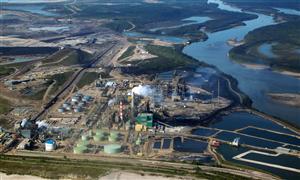Upgrading of the Oil Sands
Bitumen recovered from the oil sands is a complex mixture of hydrocarbons, and contains “impurities” such as sulphur, nitrogen, and trace metals such as vanadium. Upgrading is the process of separating and modifying the components of bitumen into various petroleum products or raw materials for further processing. Synthetic crude oil, which can be refined into numerous consumer products, is the main product of upgrading.
Upgrading relies on heating (thermal conversion, or coking), catalytic conversion, distillation, and hydrotreating to modify existing molecular structures and isolate, stabilize, and purify various molecular components. Different combinations or variations of these processes are used by different companies to produce the desired end product and byproducts. A brief description of these upgrading processes is found below (OSDC 2008d; Gray 2001):
- Thermal Conversion (Coking) uses high temperatures to break carbon-carbon bonds in long, heavy carbon chains, forming smaller, refineable molecules. Coking is useful for forming lighter hydrocarbons such as naphtha, kerosene distillates, and gas oils from bitumen, and concentrates remaining carbon into a byproduct called coke, used as a fuel to generate the heat needed for this process.
- Catalytic Conversion is also used to crack large hydrocarbons into lighter, refineable molecules. Catalytic conversion also uses high temperatures, but differs from thermal conversion in that it uses a catalyst to enhance the cracking reaction. Both stable and unstable (unsaturated alkenes) products are formed in catalytic conversion; the addition of high-pressure hydrogen is sometimes added to increase the hydrogen content of and stabilize the unsaturated products in a process known as hydroprocessing.
- Distillation uses the different boiling points of hydrocarbon compounds to isolate various components of a hydrocarbon mixture. Hydrocarbons travel as a vapour along a distillation (or fractionating) tower—heated to different temperatures along its length—and condense as liquid at various points along the tower according to their boiling points. The different fractions, including heavy and light gas oils, kerosene, and naphtha, are then collected.
- Hydrotreating is the process of mixing heated hydrocarbons with hydrogen at high temperature and pressure in order to add hydrogen atoms to unsaturated molecules (e.g., alkenes). This stabilizes the unsaturated molecules, which would continue to undergo chemical reactions en route to final refining, and also reduces or removes impurities such as nitrogen, sulphur, and trace metals from the hydrocarbon products.
Upgraded petroleum products are stored on site in large tanks until they are blended and sent down the pipeline for further refining.









